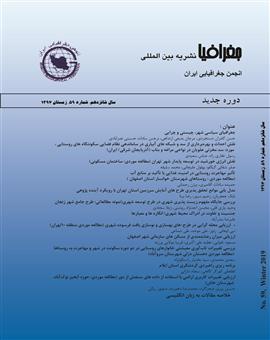تأثیر مهاجرت روستایی در امنیت غذایی با تأکید بر منابع آب (مطالعه موردی : روستاهای شهرستان خوانسار استان اصفهان )
محورهای موضوعی :حمیده سادات آقامیری 1 , بیژن رحمانی 2
1 - دانشگاه شهید بهشتی
2 - شهید بهشتی
کلید واژه:
چکیده مقاله :
پژوهش حاضر به منظور بررسی تأثیر بحران آب بر مهاجرت روستایی و امنیت غذایی در روستاهای شهرستان خوانسار صورت گرفته است . آمارها نشان می دهد در سال های اخیر کاهش منابع آب روستایی منجر به افزایش مهاجرت در این منطقه شده ، جمعیت کشاورز روستایی کاهش و بر سطح تولید و امنیت غذایی اثر گذاشته است. بر این اساس، سوال اصلی این تحقیق این است که آیا مهاجرت روستایی ناشی از منابع آب تهدیدی برای امنیت غذایی در مقیاس کل است؟ برای پاسخ به این سوال با توجه به نگرش منطقه ای تحقیق ابتدا وضعیت منابع آب روستایی در این نقاط و سطح استان بررسی و در ادامه تعاریف مختلف از امنیت غذایی مورد ارزیابی قرار گرفت . با توجه به نظریه ها و شاخص های تحقیق 5 روستا از 3 دهستان بخش مرکزی خوانسار به صورت تصادفی سیستماتیک انتخاب شد . شاخص مهاجرت در کنار امنیت غذایی بررسی و با توجه به ارتباط نزدیک امنیت غذایی و کشاورزی شرایط اجتماعی و اقتصادی روستاییان در این بخش مورد توجه ویژه قرار گرفت . این شاخص شامل اهداف و سن مهاجرت، شرایط محیطی ، اقتصادی و اجتماعی مهاجران روستایی است. نتایج پژوهش نشان داد بیش از 60٪ مهاجرت به صورت مهاجرت روستاشهری است که جوانان در رأس قرار دارند. بنابراین، کاهش نیروی کار در جامعه روستایی و تفاوت جنسی به دلیل درصد بالای مهاجرت مردان نسبت به زنان، نتیجه اصلی وضعیت مهاجرت های وابسته به آب در مناطق روستایی بود. طبق نتایج با وجود رابطه نزدیک بین کشاورزی و امنیت غذایی، افزایش مهاجرت روستایی به دلیل آب، باعث کاهش نیروی تولید در روستاها شده و تهدید جدی برای امنیت غذایی است. این تحقیق یک یادآوری است که با با استفاده از روش توصيفی- تحليلی انجام شده و با توجه به تأثیر این مهاجرت در شرایط اقتصادی بررسی تئوری های اقتصادی در این بخش در رأس قرار دارد. نتیجه گیری این بررسی بر اساس ضریب همبستگی کندال صورت گرفته است .
The present study was conducted to investigate the impact of water crisis on rural migration and food security in rural place in Khansar. Statistics show that in recent years, the decline in rural water resources has led to an increase in immigration in the area, reducing the rural farmer's population and affecting the level of production and food security. Accordingly, the main question of this research is whether rural immigration from water resources is a threat to global food security? To answer this question, considering the regional attitude of the research, firstly, the status of rural water resources in these areas and the province was investigated and further the various definitions of food security were evaluated. According to theories and research indicators, 5 villages from 3 districts of central Khansar were randomly selected. Immigration index along with food security has been investigated and due to the close relationship between food security and agriculture, the social and economic conditions of villagers in this section have been considered. This indicator includes the goals and age of immigration, the environmental, economic and social conditions of rural migrants. The results of the study showed that more than 60% of immigration is migratory to rural areas where young people are at the top. Therefore, the decline in workforce in rural society and gender differences due to the high percentage of men migrating to women was the main outcome of the status of water dependent migration in rural areas. According to the results, despite the close relationship between agriculture and food security, the increase in rural migration due to water has reduced the production capacity of the villages and poses a serious threat to food security. This research is a reminder that has been done using descriptive-analytic method and considering the impact of this migration on economic conditions, the study of economic theory in this section is at the forefront. The conclusion of this study is based on the correlation coefficient of Kendall.


